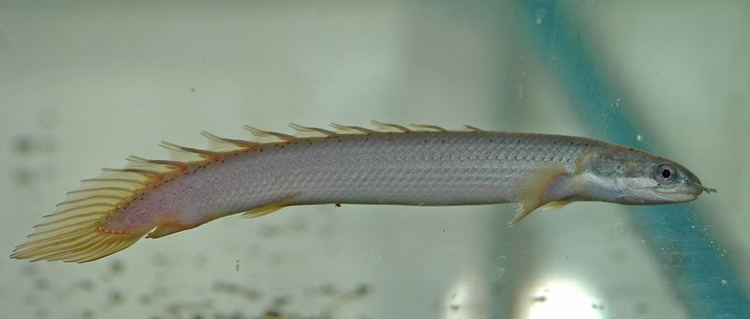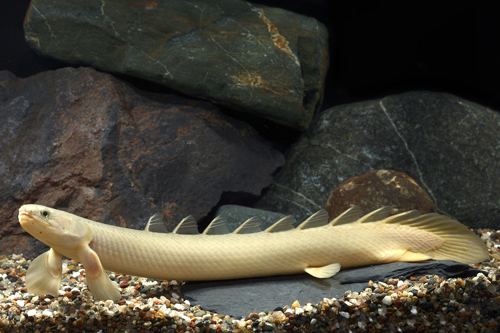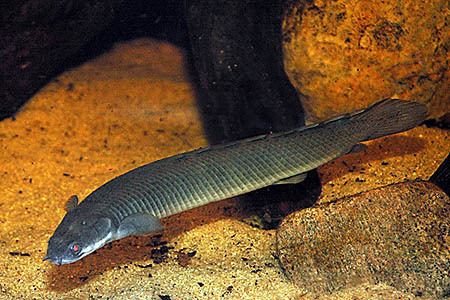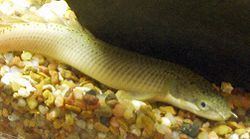Subclass Chondrostei Family Polypteridae Rank Species | Phylum Chordata Order Polypteriformes Genus Polypterus Higher classification Polypterus | |
 | ||
Similar Bichir, Polypterus, Polypterus endlicheri endlicheri, Barred bichir, Polypterus ornatipinnis | ||
All about polypterus senegalus dinosaur bichir fish in the spotlight ep 1
The Senegal bichir (Polypterus senegalus) also known as the gray bichir and Cuvier's bichir, is sometimes called the "dinosaur eel" (a misnomer, as the creature is neither an eel nor a dinosaur) also called "Dinosaur Bichir" or "dragon fish" in the pet trade. It is a prototypical species of fish in the Polypterus genus, meaning most of its features are held across the genus. Commonly kept in captivity by hobbyists. They are native from Africa where they are the most widespread species of the genus.
Contents
- All about polypterus senegalus dinosaur bichir fish in the spotlight ep 1
- Appearance
- Behavior
- Subspecies
- Distribution and habitat
- Captivity
- References

Appearance

An elongated fish, usually grey or beige in color, it sometimes has shades of white, pink or blue on some scales; most of the fish is covered in very subtle patterns with occasional darker blotches or dots. The face is smooth and rounded at the nose with larger scales than the rest of the fish, external nostrils protrude from the front; eyes are on each side of the head, they are usually pale yellow with a black pupil; the mouth is large and seems to grin when closed. The body is long and vaguely cylindrical; a serrated dorsal fin runs along most of the body until it meets the caudal fin which is pointed and flat. The pectoral fins attach just behind and below the gill openings, and are the primary means of locomotion, providing a slow, graceful appearance. P. senegalus is smaller than other bichirs, reaching about 35.5 cm (14 in).

The fish has a pair of primitive lungs instead of a swim bladder, allowing it to periodically gulp air from the surface of the water. In the aquarium, bichirs can be observed dashing to the surface for this purpose.

This bichir's skin serves as a particularly effective armor, and has been studied as a model for personal armor for better combinations of protection and mobility.
Behavior

During active hours, Polypterus senegalus swim about their environment, performing activities such as exploring, feeding, hunting, investigating changes, and scavenging; social behavior is also observed as P. senegalus sometimes follow each other moving about; most individuals are inactive at night and rest low above the ground until sunrise.
Subspecies
Three subspecies of P. senegalus are recognized: P. s. senegalus, P. s. meridionalis, and a further unnamed subspecies.

Distribution and habitat
This species of bichir is found in lakes, river margins, swamps, and floodplains of tropical Africa and the Nile river system, it occurs in at least twenty-six African countries which include Senegal, Egypt, Democratic Republic of Congo, Cameroon, Chad, Ethiopia, Kenya, Mali, Ivory Coast, Tanzania, Sudan, Nigeria, Gambia, Uganda, and others. Its distribution is widespread, detailed to include the Nile basin and West Africa (Senegal, Gambia, Niger, Volta, and Lake Chad basins, and Congo River Basin.
Captivity
Bichirs are predatory fish; in captivity they will take any live or dead animal that can be swallowed or broken apart and then swallowed. Only its lack of speed prevents a bichir from emptying an aquarium of smaller fish; the pectoral fins only allow for slow cruising, and while it can achieve amazing bursts of speed, it cannot catch fish of average speed. Given enough time, any fish that can fit in the bichir's mouth will be eaten; this fish should not be kept with any other fish smaller than three inches. It will also bite fins of other fishes if it can.
Provided the skin remains moist, P. senegalus can remain out of the water indefinitely – it can even be raised on land, where it uses its large pectoral fins to walk.
